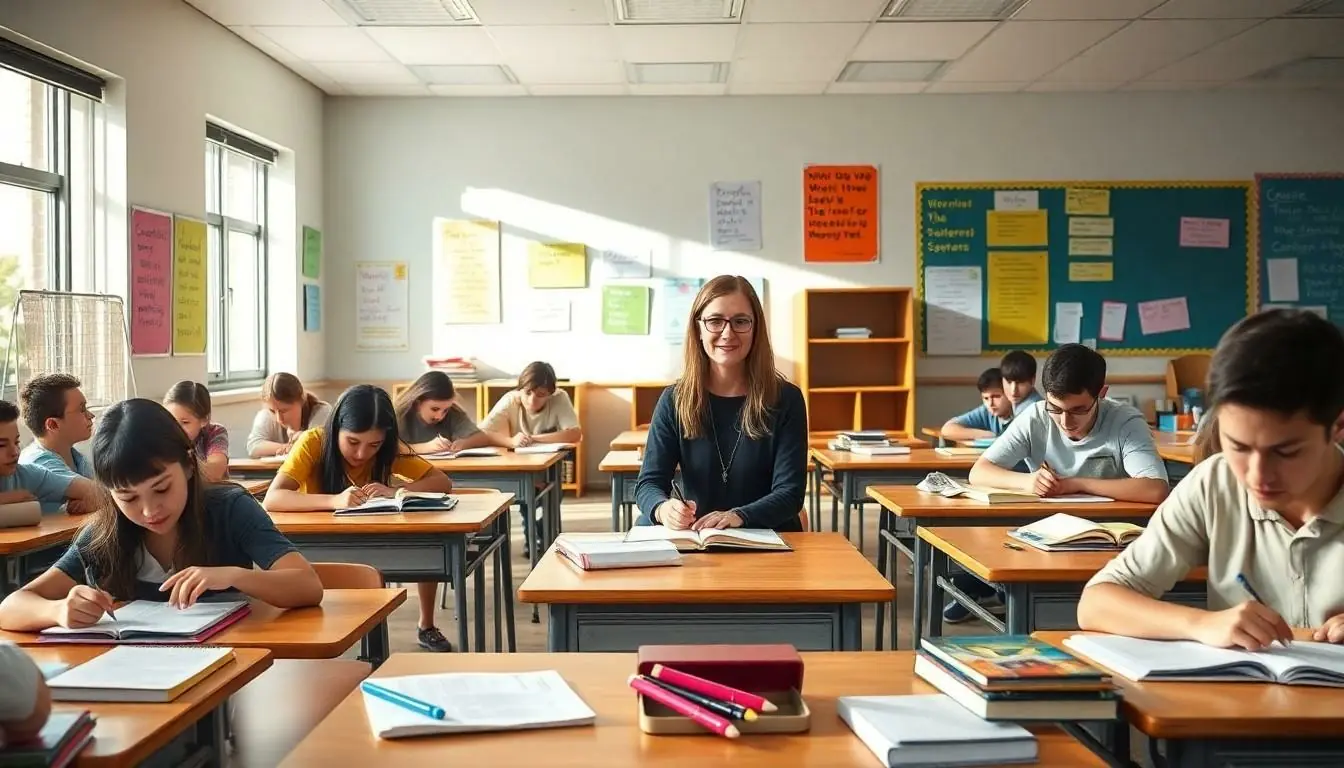High school can feel like a never-ending cycle of textbooks and tests, but what if there’s a way to break free and unleash some creativity? Enter creative writing prompts. They’re not just for aspiring novelists or poets; they’re a secret weapon for students looking to spice up their writing skills while having a blast.
Table of Contents
ToggleOverview of Creative Writing Prompts
Creative writing prompts serve multiple purposes in high school education. They inspire students to explore different genres and styles. Writing prompts encourage original thought and self-expression. Various prompts can include scenarios, character sketches, or thematic explorations, catering to diverse interests.
Engagement in creative writing fosters critical thinking and problem-solving skills. Students develop their voice and style through regular practice. A prompt about a mysterious object can spark intrigue and innovation, encouraging students to invent backstories and plotlines. Vivid imagery in prompts may enhance descriptive writing capabilities.
High school educators recognize the versatility of prompts. Simple prompts can adapt to the classroom setting, allowing for group discussions or solitary reflection. Using technology, students can share stories online or in forums, creating a collaborative writing experience.
Benefits of creative writing prompts extend beyond individual performance. They help to build a classroom environment that values creativity and collaboration. Sharing results in peer feedback can boost confidence and enhance writing skills. Prompts can also serve as starting points for larger writing projects, such as short stories or essays.
Quantifying improvement shows that creativity in writing leads to better academic outcomes. Studies indicate that students who engage with creative writing score higher in overall language proficiency. Incorporating diverse prompts into the curriculum supports both creative freedom and structured learning.
Benefits of Using Writing Prompts in High School

Using writing prompts offers various advantages for high school students, enhancing their writing experience and skill development.
Enhancing Creativity
Creativity flourishes with the use of writing prompts. They stimulate fresh ideas and encourage exploration beyond conventional boundaries. Diverse prompts inspire students to venture into various genres and styles. Original scenarios spark imagination, leading to unique narratives that reflect individual perspectives. Engaging with prompts nurtures an innovative mindset, as students experiment with different writing techniques. Ultimately, creativity becomes a vital component of their academic journey, fostering a love for expression.
Encouraging Self-Expression
Self-expression finds a strong foundation in writing prompts. Students articulate their thoughts, feelings, and experiences through personalized narratives. With prompts tailored to diverse interests, each individual can connect deeply with the subject matter. They gain confidence as their voices emerge, allowing for authentic storytelling. Exploring themes that resonate with them enhances emotional intelligence. Providing an outlet for thoughts promotes mental well-being, transforming writing into a powerful tool for self-discovery. Utilizing prompts, students discover their unique styles while growing as writers and individuals.
Types of Creative Writing Prompts
Creative writing prompts can be categorized into distinct types, each serving a specific purpose in enhancing students’ writing skills.
Narrative Prompts
Narrative prompts often encourage storytelling using characters, settings, and plots. These prompts might ask students to recount a personal experience or craft a fictional story about a unique adventure. For example, a prompt could ask students to describe a day when everything went wrong, focusing on developing tension and resolution. Engaging with narrative prompts allows students to explore their imagination and strengthen their narrative techniques while practicing dialogue and character development.
Descriptive Prompts
Descriptive prompts focus on sensory details to create vivid imagery. In these exercises, students can be asked to describe a familiar place, such as their favorite park, or an object, like a cherished family heirloom. By concentrating on sight, sound, smell, taste, and touch, students enhance their ability to paint pictures with words. This mastery of detail enriches their narratives and develops their proficiency in capturing emotions and settings, making their writing more engaging and immersive.
Poetry Prompts
Poetry prompts invite students to experiment with language and form, encouraging a different creative approach. These prompts might ask students to write a poem about a specific emotion or reflect on a significant moment in their lives. By exploring various poetic devices, such as rhyme, rhythm, and metaphor, students can find new ways to express their thoughts and feelings. Engaging with poetry fosters creativity and emotional expression, inviting them to interpret their experiences in unique ways.
Tips for Implementing Prompts in the Classroom
Incorporating creative writing prompts enhances student engagement and fosters a supportive writing community. Utilizing effective strategies ensures prompts resonate with high school students.
Engaging Students
Active participation increases when prompts connect with students’ interests and experiences. Offering a choice among various prompts caters to diverse preferences. Incorporating multimedia elements like images or music can spark creativity and inspire unique responses. Allowing time for sharing written pieces not only fosters dialogue but also encourages collaboration. Engaging in small group discussions boosts confidence as students voice ideas and gain new perspectives. Using prompts that are relatable and current ensures maximum involvement, helping students invest more in their writing journey.
Creating a Supportive Environment
A classroom atmosphere that promotes creativity nurtures students’ confidence in their writing abilities. Establishing clear guidelines for feedback can create a safe space for sharing work. Encouraging positive reinforcement allows students to feel supported and motivated to take risks. Regularly showcasing student work fosters a sense of pride and belonging among peers. Practicing collaborative exercises builds trust, as students learn from each other while expanding their skills. Implementing this supportive framework ultimately enhances overall engagement and the quality of writing produced.
Creative writing prompts are invaluable tools for high school students seeking to enhance their writing skills. They not only spark imagination but also provide a refreshing break from conventional learning methods. By encouraging exploration of different genres and styles, prompts foster original thought and self-expression.
The adaptability of these prompts makes them suitable for various classroom settings, whether in group discussions or individual reflections. As students engage with creative writing, they build confidence and develop their unique voices. This journey not only improves language proficiency but also cultivates critical thinking and emotional intelligence. Ultimately, incorporating creative writing prompts into the curriculum can transform the writing experience into a powerful avenue for personal growth and academic success.



